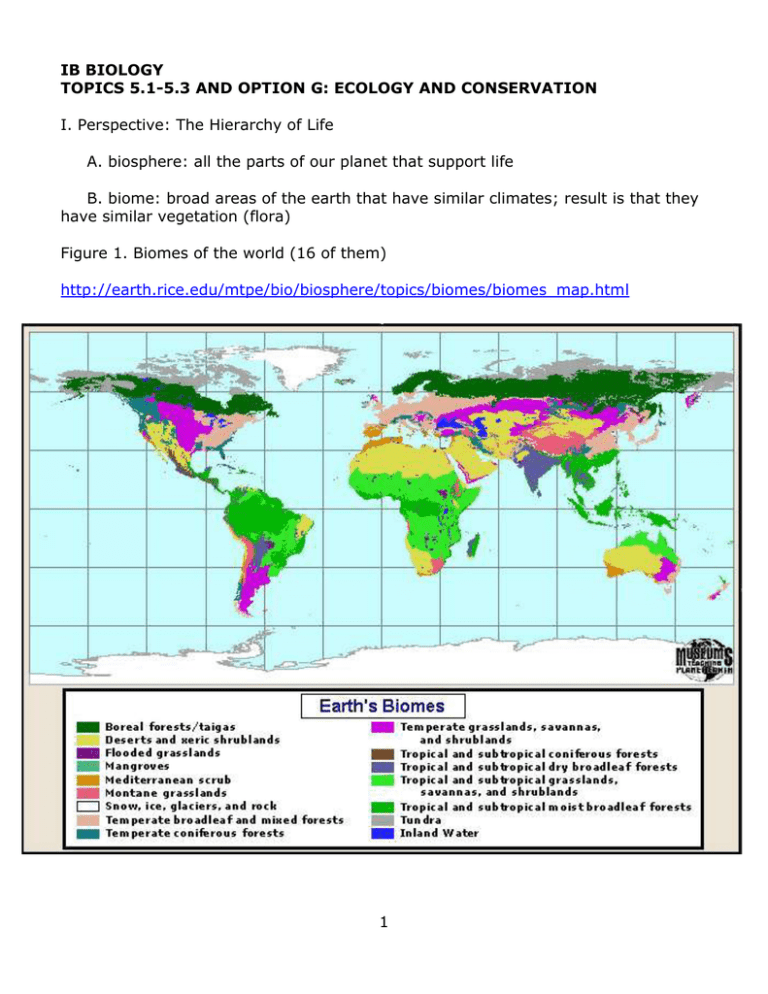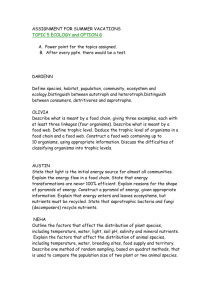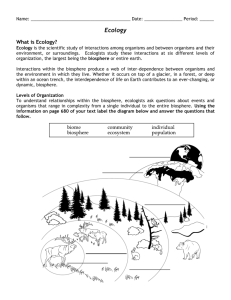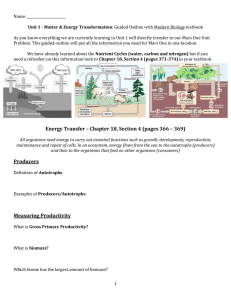complete Ecology notes so far
advertisement

IB BIOLOGY TOPICS 5.1-5.3 AND OPTION G: ECOLOGY AND CONSERVATION I. Perspective: The Hierarchy of Life A. biosphere: all the parts of our planet that support life B. biome: broad areas of the earth that have similar climates; result is that they have similar vegetation (flora) Figure 1. Biomes of the world (16 of them) http://earth.rice.edu/mtpe/bio/biosphere/topics/biomes/biomes_map.html 1 Figure 2.Biomes of the world (14 of them). http://www.emc.maricopa.edu/faculty/farabee/biobk/biobookcommecosys.html 2 Figure 3.Biomes of the world (10 of them). Q: Why aren’t these maps the same? 1. Remember that biomes are largely dependent on precipitation and temperature. Roger Whittaker plotted rainfall versus temperature graphs for many locations worldwide and then shaded in the graph based on the biomes that were represented. One such graph is shown below and can be used to predict the biome based on rainfall and temperature. Use the table below to practice on the handout provided. 3 Figure 4.Precipitation versus Temperature graph for various biomes. *Note that this is just one variation on the graph. Others are possible. Why? See the website below for details. http://www.marietta.edu/~biol/biomes/biome_main.htm 2. Biomes specifically mentioned in the IB syllabus: desert, grassland, shrubland (chaparral, matorral, maquis and garigue, dry heathlands, fynbos), temperate deciduous forest, tropical rainforest and tundra 3. Where do we live? 4. Assignment: See handout. 4 C. Ecosystem: all of the organisms in an area as well as the non-living components with which they interact 1. biotic: living 2. abiotic: non-living Figure 5.An example of an ecosystem. What is in it? https://docs.google.com/present/view?id=dfh23k67_2452gjf8bfdp D. Community: all of the organisms that live in a particular ecosystem E. Population: all of the organisms of the same species that live in a particular ecosystem/specified area 1. species: organisms that can successfully interbreed in the wild F. Organism: an individual of one type of living thing G. Organ System: several organs that work together to perform specific functions e.g. the circulatory system is made of the heart and the blood vessels H. Organ: a group of tissues that work together to perform one specific task e.g. the heart pumps blood throughout the body I. Tissues: a group of similar cells with a specific function e.g. the heart tissues include cardiac muscle and pericardium 5 J. Cells: the simplest structures that exhibit all the characteristics of living things and are separated from their environments by a cell membrane/phospholipid bilayer K. Organelle: a small structure within a cell that performs a specific function for the cell (with the exception of ribosomes have their own membranes) L. Molecule: a group of 2 or more atoms held together in specific proportions by chemical bonds M. Atom: the smallest particle of ordinary matter that exhibits the physical and chemical properties of a specific element Figure 6.The hierarchy of biology. http://mycozynook.com/1_1hierarchy.jpg 6 II. Ecology A. ecology: the study of the interactions between the living and non-living components of an ecosystem i.e. their environments 7 III. The Flow of Matter (Nutrients) and Energy *note that for energy, the biosphere is an open system as energy can enter or leave and ecosystem but that for matter/nutrients, the biosphere is a closed system as matter can only be recycled A. most of the energy used by living things comes originally from the sun 1. plant efficiency in converting sunlight to chemical energy ranges from 0.1% to 8% and is about 1% to 2% in crop plants (http://www.life.illinois.edu/govindjee/whatisit.htm) B. some organisms can obtain energy from inorganic chemical sources 1. around ocean vents, there are communities where bacteria can oxidize hydrogen sulphide to produce energy-rich compounds 2. the process used to make the energy available to organisms is called chemosynthesis C. Classifying organisms by energy source 1. autotroph: (auto=self, troph=nourish (I personally always think “eat”)) organism that can produce organic molecules from inorganic materials a. photoautotroph: uses light as the energy source i. plants, some protists, some bacteria, some cyanobacteria b. chemoautotroph: uses an inorganic molecule as the energy source (by oxidizing it) i. only some bacteria and archaeons (archaebacteria in some literature but that name seems to have been rejected since they are so genetically dissimilar from the eubacteria) http://www.ucmp.berkeley.edu/archaea/archaea.html 2. heterotroph: (hetero=different) organisms that obtain energy from organic molecules that were made by other organisms 3. producer: organisms (usually photosynthetic*) that provide food for an ecosystem by transforming one form of energy (usually sunlight*) to the stored energy in an organic molecule (usually glucose*) a. synonym=autotroph 8 *recall that some ecosystems rely on chemosynthetic organisms 4. consumer: organisms that must use energy from organic molecules that were made by other organisms a. synonym=heterotroph b. primary (1) consumer: gets energy from producers c. secondary (2) consumer: gets energy from primary consumers d. tertiary (3) consumer: gets energy from secondary consumers e. higher-order consumer: gets energy from tertiary (or higher-order) consumers 5. trophic level: feeding level; producer, primary consumer, secondary consumer, etc. 6. herbivore:(herb=plant, vore=eat)gets energy from plants, a primary consumer 7. carnivore:(carn=flesh) gets energy from animals, a secondary (or higher order) consumer 8. omnivore:(omni=all) gets energy from both plants and animals 9. detritovore:an organism that ingests non-living organic matter 10. saprotroph: an organism that lives on or in non-living organic matter and digests it by secreting digestive enzymes and then absorbing the digested materials a. usually bacteria, fungi, protists 11. saprophyte: older term that was replaced by saprotroph because “phyte” implies a plant but no plants are true saptrotrophs 12. saprophages: organisms that are scavengers and ingest dead organic matter 13. decomposers: organisms that break down non-living organic matter into inorganic matter a. saprotrophs are decomposers 9 D. Food chains and food webs transfer matter and energy 1. Food chain: a simple representation of energy flow through a community shown using a series of organisms linked by the fact that, beginning with the producer/autotroph, each successive organism feeds on the preceding organism a. the arrow always points in the directions of nutrient/matter and energy flow Figure 7.Examples of terrestrial and aquatic food chains. http://berryberrychallenge.blogspot.com/2011/05/food-webs-in-san-pablo.html 10 2. Food web: a number of interconnected food chains a. note that because of the nature of feeding relationships, it is often difficult to definitively classify the trophic level of a heterotroph 11 Figure 8. An aquatic food web (mainly). http://www.ibguides.com/biology/notes/communities-and-ecosystems 12 13 Figure 9.A terrestrial food web. http://www.bcscience.com/bc10/pgs/quiz_section2.1.htm E. The efficiency of energy transfer 1. Reasons that the transfer will not be 100% a. energy is incorporated in tissues b. energy of metabolism: energy is used for daily activities such as muscle contraction, growth, nerve impulse transmission, active forms of transport across the cell membrane etc. 14 c. energy that is stored in organic waste 2. the 10% rule: when data is not available, a reasonable guess/estimate is that 10% of the energy from one trophic level is transferred to the next F. Ecological Pyramids: graphic representations of the amount of some measureable quantity in each trophic level Figure 10.Examples of ecological pyramids. http://scienceaid.co.uk/biology/ecology/food.html 1. Pyramid of Numbers: the number or organisms at each trophic level found in a given area a. generally, the number of organisms at each trophic level decreases along the food chain b. organisms at at lower trophic levels tend to be smaller in size than those at higher trophic levels, thus, there can be more of them c. both a and b arise as a consequence of biomass relationships for the trophic levels 15 d. note that in some ecosystems, the number of producers can be fewer than the number of some consumers resulting in an inverted pyramid i. a large tree may support many small animals or one individual can support many parasites ii. there can sometimes be a smaller number of phytoplankton that supports a larger number of zooplankton 2. Pyramid of Biomass: the total mass of organisms at each trophic level found in a given area a. found by first drying the organic material b. gives a rough estimate of amount of stored energy i. not totally accurate because different tissue types have different amounts of stored energy c. the smaller biomass at higher trophic levels results from: i. not all of the organisms at a trophic level get eaten by the next trophic level ii. some of the food that is eaten is undigested and passes out of the body of the consumer iii. the energy stored in the food is used by the organism for metabolism iv. only about 10% of the energy available at a particular trophic level is incorporated into the tissues of the organisms at the next trophic level a. this is why it would be more possible to feed a growing world population if all humans maintained a plant-based diet d. an inverted pyramid appears when the producers, such as phytoplankton, grow, reproduce, and get consumed very quickly so that the total biomass at any given time is small 3. Pyramid of Energy or Productivity: the total amount of energy stored in the tissues of the organisms at each trophic level in a given area a. gross primary production: the total energy stored in the tissues of the plant 16 b. net primary production: gross production minus the energy used for respiration c. note that this pyramid never has an inverted shape G. Biogeochemical cycles: the movement of biologically significant elements through the biotic and abiotic components of ecosystems 1. Carbon cycle Figure 11.The carbon cycle. http://kentsimmons.uwinnipeg.ca/16cm05/1116/16ecosys.htm 17 2. Nitrogen cycle Figure 12.The nitrogen cycle.http://bioh.wikispaces.com/More+Elemental+Cycles 18 3. Phosphorus cycle Figure 13.The phosphorus cycle.http://bioh.wikispaces.com/More+Elemental+Cycles 19 IV. Populations A. What controls the size of a population? 1. Immigration: individuals of a species move into an area 2. Emigration: individuals of a species move out of an area 3. Mortality: individuals in a population die 4. Natality: individuals in a population are born 5. Immigration + Natality = Emigration + Mortality --> stable population size 6. Immigration + Natality > Emigration + Mortality --> increased population size 7. Immigration + Natality < Emigration + Mortality --> decreased population size 8. r (population growth rate)= Immigration + Natality - (Emigration + Mortality) B. Population growth 1. In ideal situations (the absence of limiting factors), population growth is maximized a. often characterized as exponential growth where the greater the population, the greater the growth rate 2. Limiting Factors a. density-dependent: effects are more pronounced as the population increases i. Competition for limited resources such as oxygen, water, food, living space, mates ii. Disease iii. Predation iv. Parasitism 20 b. Density-independent: the effects are consistent regardless of population size i. catastrophic events such as floods, drought, volcanic eruptions etc. ii. environmental changes 3. Growth curves Figure 14 (a) Exponential and (b) logistic growth curves. http://www.emc.maricopa.edu/faculty/farabee/biobk/biobookpopecol.html 21 Figure 15. Exponential and logistic growth curves on the same set of axes. http://kentsimmons.uwinnipeg.ca/16cm05/1116/16popbio.htm a. Exponential Growth Curves i. unrealistic because do not take into account limiting factors b. Logistic Growth Curves i. do take into account limiting factors 22 ii. Carrying Capacity (K): the maximum sustainable population in a given area iii. at first, r increases (exponential phase) a. natality > mortality b. resources are plentiful c. predation and disease are rare iv. then r begins to decrease (transition phase) a. natality begins to decrease and/or mortality begins to increase b. resources become less plentiful c. predation and disease increase v. r becomes 0 (plateau phase) a. natality and mortality equalize b. predation and disease rates are stable c. population has reached carrying capacity Reinforcement: 1. Chapter 14: Graph and analyze the bison population of Yellowstone Park-Carry out the procedure and answer the questions in complete sentences. http://www.classzone.com/cz/books/bio_07/page_build.htm?id=resources/jsp /data_analysis/data_analysis 2. Effort and accuracy of population estimates-Answer the questions for both the area-based model and the mark-recapture models. http://sites.sinauer.com/ecology2e/problem08.html 23 4. r-strategies versus K-strategies Figure 16. 3 generalized survivorship curves. http://kentsimmons.uwinnipeg.ca/16cm05/cm16ppt06/Population%20Ecology_files/ v3_document.htm a. r-strategies: tend to maximize r (the rate of population growth) b. K-strategies: tend to maintain the population at K (the carrying capacity of an ecosystem) 24 Table 1. Characteristics of r-strategists and K-strategists. http://kentsimmons.uwinnipeg.ca/16cm05/cm16ppt06/Population%20Ecology_files/ v3_document.htm 25 Table 2. Characteristics of r-strategists and K-strategists. http://content.bfwpub.com/webroot_pubcontent/Content/BCS_3/Sadava_9e/Interac tive%20Summaries/5510.html Q: Categorize each of the three general types of survivorship curves as representative of r-strategists or K-strategists. Here is an animation: http://highered.mcgrawhill.com/olcweb/cgi/pluginpop.cgi?it=swf::525::530::/sites/dl/free/007340344x/805 265/R_and_K_Strategies.swf::R%20and%20K%20Strategies 26 5. Factors that affect the distribution of organisms a. Plants i. temperature ii. precipitation/water iii. light iv. soil composition (pH, salinity, nutrient concentration) and texture b. Animals i. temperature ii. precipitation/water iii. breeding sites/territory iv. food supply V. Communities A. Terminology 1. habitat: the physical location where an organism lives 2. competition: two (or more) species rely on the same limited resource 3. predation: an animal species (the predator) eats another animal species (the prey) Figure 17. Population growth cycles of predator and prey (lynx and snowshoe hare). http://kentsimmons.uwinnipeg.ca/16cm05/cm16ppt06/Population%20Ecology_files/ v3_document.htm 27 4. herbivory: an animal species eats a plant species 5. symbiosis: an interspecific interaction where the two species maintain a close association with each other (often one species lives on/in the host species) a. mutualism: both species benefit from the relationship (+,+) i. the clownfish and the sea anemone: the clownfish eats scraps from the sea anemone and keeps it clean while the sea anemone provides protection from predators to the clownfish ii. the large blue butterfly of the UK and a certain species of ant: the larvae of the large blue butterfly secrete a substance that the ant drinks and then the ant carries the larvae to their nests where the 28 larvae eat ant larvae, then pupate (this butterfly went extinct in the UK but was reintroduced from Sweden in 2009) *note that there are many relationships of this type where one animal “farms” another http://www.telegraph.co.uk/earth/wildlife/5542084/Large-Blue-butterfly-fluttersback-from-extinction-thanks-to-a-tiny-ant.html iii. ants and acacia trees: Figure 18. An investigation into the type of relationship between Acacia trees and ants. 29 http://content.bfwpub.com/webroot_pubcontent/Content/BCS_3/Sadava_9e/Interac tive%20Summaries/5610.html b. parasitism: one species benefits from the relationship while the other is harmed (+,-) c. commensalism*: one species benefits from the relationship while the other is unaffected (+,0) *not in IB syllabus d. amensalism*: one species is unaffected but the other is harmed (0,-) 6. niche: the role of the organism in its habitat; encompasses its relationships with other organisms, feeding activities and spatial habitat a. fundamental niche: the potential niche of an organism when competition is not severe b. realized niche: the actual niche occupied by an organism when competition is severe 30 Figure 19. Fundamental and real niches of two species of barnacles. http://kentsimmons.uwinnipeg.ca/16cm05/1116/16comeco.htm In this example, the fundamental niches of the two species overlap. This was discovered by allowing each species to grow without the other and determining what part of the habitat was utilized. Q: Which of the two species outcompetes the other one? 7. competitive exclusion: two species that require exactly the same resources (including physical habitat, food/nutrients etc.) cannot be found in the same community a. the species that uses the resources better will reproduce more quickly and pushes out the other species 31 Figures 20, 21 and 22. A classic example of competitive exclusion by Gause involving Paramecium caudatum and Paramecium aurelia. http://www.emc.maricopa.edu/faculty/farabee/biobk/biobookpopecol.html What is K? What is K? 32 What happened? 7. Niche differentiation: species that have similar niches (and are thus competitors) utilize the same niche but in slightly different ways a. note that this implies that natural selection has influenced the development of the structures and behaviours of the species b. Resource partitioning: species that have similar niches behave in such as was as to reduce competition i. the competing species may use the resource at different times ii. the competing species may use the same resource but in different parts of the habitat iii. the competing species may use slightly different parts of the same food source because they have morphological/physical differences that make them better able to make use of one part of the resource than another Figure 23. Resource partitioning among bumblebees in Colorado. The bumblebees with longer proboscides/proboscises utilize flowers with longer corollas. They reduce competition by being found at different altitudes. The bumblebees with shorter proboscides/proboscises utilize flowers with shorter corollas. They, too, reduce competition by being found at different altitudes. http://www.nature.com/scitable/knowledge/library/resource-partitioning-and-whyit-matters-17362658 33 Figure 24. Resource partitioning among warblers. http://www.citruscollege.edu/lc/archive/biology/Pages/Chapter43-Rabitoy.aspx 34 C. Succession: the changes in a community over time as some species enter the area and some species become locally extinct or leave the area 1. the presence of a species often changes the community both in terms of biotic and abiotic factors so that it becomes more or less ideal for other species (known as facilitation) 2. Primary succession: occurs in an area that is devoid of life such as new volcanic islands or glacial moraines a. the first species to colonize an area are called pioneer species i. usually small plants such as mosses or lichens a. able to grow on bare rock b. can help to break down the rock into soil (some mosses produce acid) and also become part of the soil when they die b. followed by small, fast-growing species such as grasses i. do not require deep soil c. next are shrubs and small trees d. followed by larger trees e. eventually there will be a stable community known as the climax community f. the whole process may take hundreds of years A brief description of primary succession in the Hawaiian island can be found here: http://hvo.wr.usgs.gov/volcanowatch/1999/99_01_21.html Animation: http://bcs.whfreeman.com/thelifewire9e/default.asp#542578__591727__ Figure 25. Primary succession on a glacial moraine. http://content.bfwpub.com/webroot_pubcontent/Content/BCS_3/Sadava_9e/Interac tive%20Summaries/5710.html 35 Figure 26. Succession in a temperate deciduous forest. http://content.bfwpub.com/webroot_pubcontent/Content/BCS_3/Sadava_9e/Interac tive%20Summaries/5710.html 36 3. Secondary succession: occurs in an area that has undergone severe disruption of the community such as a fire or volcanic eruption a. the time to reach a climax community is less because there is already soil and because seeds and spores of plants may already be present 4. The final climax community is dependent on the same factors that affect plant and animal distributions as well as the history of the area 5. As succession continues: a. net productivity increases 37 b. the biomass of the community increases c. species diversity increases d. the climax community is occurs when the aforementioned values reach a plateau i. heterotrophs in the community balance out the increase in autotrophs’ efficiency Figure 27. Net productivity, biomass and species number changes during secondary succession in a temperate deciduous forest. http://users.rcn.com/jkimball.ma.ultranet/BiologyPages/S/Succession.html Q: Why do the descriptions of succession omit description/discussion of animals? References: 1. http://www.emc.maricopa.edu/faculty/farabee/biobk/biobookcommecosys.htm l 2. Biomes of the world website: http://www.marietta.edu/~biol/biomes/biome_main.htm 38 3. http://www.mycozynook.com/101RGCh1OH.htm 4. Information about terrestrial biomes: http://www.nature.com/scitable/knowledge/library/terrestrial-biomes13236757 5. A nice powerpoint with coverage of many basic concepts and useful images. https://docs.google.com/present/view?id=dfh23k67_2452gjf8bfdp 6. This page is part of a site that chronicles a deep-sea mission in 2000: http://www.ceoe.udel.edu/deepsea/level-2/chemistry/chemo.html 7. http://www.deltacollege.edu/emp/jdebow/energytransfer.html 8. http://kentsimmons.uwinnipeg.ca/16cm05/1116/16comeco.htm#Interspecific %20Competition 9. http://www.mansfield.ohio-state.edu/~sabedon/campbl52.htm 10. http://www.nature.com/scitable/knowledge/library/resourcepartitioning-and-why-it-matters-17362658 11. http://bcs.whfreeman.com/thelifewire9e/default.asp#542578__591730_ _ 12. http://www.citruscollege.edu/lc/archive/biology/Pages/Chapter43Rabitoy.aspx 13. For practice and review: There are other chapters associated with each book that might be useful. 1. http://highered.mcgrawhill.com/sites/0073031208/student_view0/chapter25/multiple_choice.html 2. http://highered.mcgrawhill.com/sites/007340344x/student_view0/chapter33/post-test.html 3. http://wps.prenhall.com/esm_audesirk_bloe_7/17/4463/1142621.cw/index.ht ml 39 40 41






